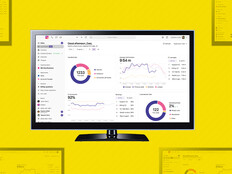How Mobility Solutions Are Improving Patient Satisfaction in Healthcare
As healthcare organizations begin planning their point-of-care engagement strategies, they can learn from the examples set by several of the field’s most prominent trailblazers. Moving more deeply into the field, healthcare providers will soon discover that patient engagement isn’t a single technology, but rather a combination of hardware, software and services solutions. When blended together, those tools provide a comprehensive ecosystem of patient, family and caregiver support that help to improve treatment, lower costs, enhance comfort, instill knowledge and calm fears.
At the cutting edge of engagement, healthcare providers are tapping into artificial intelligence to treat patients more proactively. New Orleans-based Ochsner Health System, for instance, recently announced an initiative to bring AI directly into patient care workflows.
Deploying a predictive model developed by its electronic health record system vendor and powered by the cloud, Ochsner believes that an AI approach will allow it to deliver rich patient insights to care teams in real time, providing the ability to detect potential adverse health events more quickly and accurately. During the course of a 90-day pilot, Ochsner’s Rapid Response Team was able to successfully reduce adverse events outside of the intensive care unit by 44 percent.
Another pioneer of AI-driven engagement, Philadelphia-based Jefferson Health system, is using natural-language processing to redefine how to provide smart, innovative patient care at Thomas Jefferson University Hospital. The facility has equipped several of its patient rooms with an AI-powered bedside platform. The device, which resembles a clock radio, allows patients to control several room functions through voice commands (including room lighting and temperature) and obtain on-demand information about hospital clinicians and services.
A microphone built into the device transmits patient queries as audio files directly to the AI platform, which then employs NLP capabilities to translate the audio into text. The platform then scans that text for trigger words to determine the nature of the question, and uses those words, the surrounding context and other data to find the requested information via a secure application programming interface.
The device then transmits an audio response to the user within two seconds.
SIGN UP: Get more news from the HealthTech newsletter in your inbox every two weeks!
Smart Devices and Bedside Apps Enhance Patient Satisfaction in Healthcare
The University of California, San Diego’s Jacobs Medical Center directly targets patient engagement and patient satisfaction in healthcare with digital tools people use everyday. Jacobs Medical Center, a 245-bed medical and surgical specialty hospital, provides admitted patients with tablets and equips their rooms with smart TVs. The technologies are designed to give patients direct control of their healthcare experience and their surroundings.
Once they arrive, patients have immediate access to the tablets, which allows them to take command of their room environment, reducing the need to call for assistance to lower shades or adjust the room temperature. The devices are also equipped with popular entertainment apps, and patients have the option to download many of their favorite apps as well. Additionally, patients have the ability to share content on the devices with clinicians and room guests on the smart TV.
The tablet also includes the MyChart Bedside app, which enables secure access to medical records. Patients simply create their own unique PIN, which grants safe and easy access to their medical records and test results. The app also allows users to view photographs and biographies of their healthcare team, a current schedule of medications and upcoming procedures and educational materials prescribed by physicians.
Interactive Interfaces Reduce Patient Readmissions
Yet another approach to patient engagement is under way at Virginia healthcare provider Carilion Clinic. Since September 2014, the organization’s Carilion Roanoke Memorial Hospital has used the GetWell Inpatient interactive patient care system to involve patients in multiple aspects of their healthcare. Understanding that engaging and motivating patients and their families is essential to both improving care and reducing readmissions, Carilion is using the technology to ensure that patients continue on the road to recovery long after they leave the hospital.
New patients at the Roanoke facility are greeted with a brief introductory video welcoming them to the hospital. After the video concludes, the patient answers a series of questions to gauge his or her comprehension of the content.
The system then notes in the EHR that the video has been completed. Later, caregivers are free to assign other videos to the patient, based on the individual’s condition, medications, planned procedures and other unique factors. Patients can also manually select resources to review again, as needed.
The system also gives patients the opportunity to communicate with staff members about issues, such as dietary restrictions, pain level or room comfort, so their needs are addressed as they arise. The approach improves the patient experience and often translates into higher Hospital Consumer Assessment of Healthcare Providers and Systems patient satisfaction scores.
GetWell content is presented as tiles on a screen, often 55- to 70-inch smart HDTVs, although organizations can use other types of devices, such as tablets mounted at the foot of a patient’s bed. Another GetWell feature is an interactive digital whiteboard that integrates with the hospital’s real-time location services. The whiteboard shows patients their daily schedule, introduces staff as they walk into the room and logs which clinicians have visited the patient.
Besides informing the patient, the system’s standardized messages help reduce staff workloads. When a caregiver has a full patient load or is in a crisis situation, he or she might not have the time to explain all the nuances of a drug to each patient. With GetWell technology, the message, evidence-based and vetted by subject-matter experts, remains the same in all circumstances.
GetWell’s Precision Engagement interface is designed to match different styles to various types of patients, based on demographics. The teen interface, for instance, uses emoticons, while GetWell Town, for younger patients, is a cartoon-based environment that replaces most text content with pictures.
To learn more download our white paper "Next-Generation Patient Engagement Technology Enhances Patient Outcomes."









